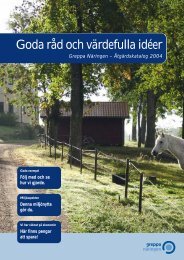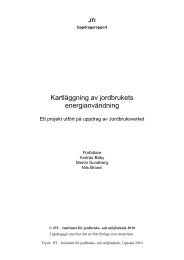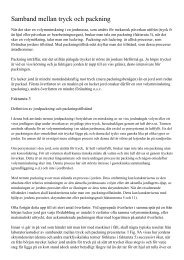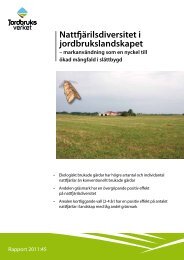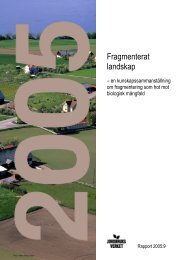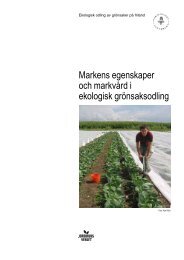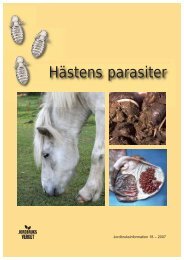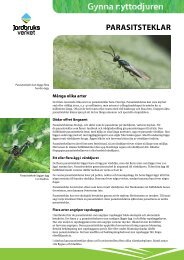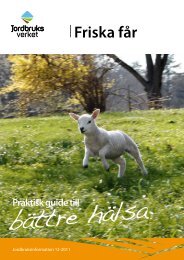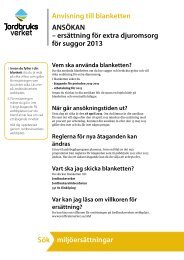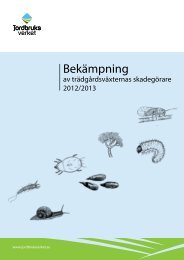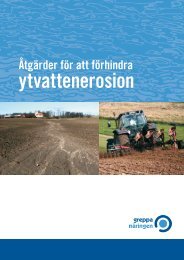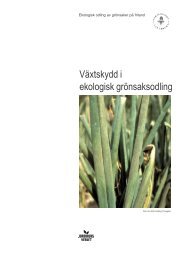Strategies for detection and delimitation surveys of ... - Jordbruksverket
Strategies for detection and delimitation surveys of ... - Jordbruksverket
Strategies for detection and delimitation surveys of ... - Jordbruksverket
You also want an ePaper? Increase the reach of your titles
YUMPU automatically turns print PDFs into web optimized ePapers that Google loves.
<strong>and</strong> up to four years old clear-cuts in northern Sweden (mainly two year generation<br />
time).<br />
6.1.4 Sampling <strong>of</strong> wood on clear-cuts<br />
The sampling <strong>of</strong> logging residue in clear-cut areas could be conducted all year<br />
around except when there is a snow cover. This means May to October in northern<br />
Sweden <strong>and</strong> at least March to November in southern Sweden depending on the<br />
snow situation. But, in order to give time <strong>for</strong> a <strong>delimitation</strong> survey (in case <strong>of</strong><br />
<strong>detection</strong>) be<strong>for</strong>e the start <strong>of</strong> the flight period <strong>of</strong> Monochamus beetles, the survey<br />
should at latest be conducted in early autumn. Preferably it should be conducted<br />
by the same persons each year because it is important to be able to recognize the<br />
larval galleries <strong>and</strong> adult emergence holes <strong>of</strong> Monochamus <strong>and</strong> the sampling procedure<br />
will be known. It is also important that the field inspectors are interested<br />
in the project which will increase the quality <strong>of</strong> the survey. Presently the <strong>surveys</strong><br />
are conducted by personal from the Swedish Board <strong>of</strong> Agriculture <strong>and</strong> generally<br />
the same persons conduct the <strong>surveys</strong> each autumn. Other possibilities would be<br />
to use personal involved in the NILS (Nationell Inventering av L<strong>and</strong>skapet i<br />
Sverige)-<strong>surveys</strong> (which have a lot <strong>of</strong> field experience but not from this particular<br />
system) or that the department <strong>of</strong> Ecology, SLU (Swedish University <strong>of</strong> Agricultural<br />
Sciences) conduct the <strong>surveys</strong>. Some disadvantages with using field assistants<br />
from the NILS-project are that they are generally not available until late<br />
September <strong>and</strong> that there is no guarantee that the same persons are available from<br />
year to year. Also the alternative that SLU is responsible would mean that there is<br />
no guarantee that the same persons are involved, especially if there is no secure<br />
long-term funding <strong>for</strong> the <strong>surveys</strong> (we would have to rely on temporarily<br />
employed field assistants). An advantage <strong>of</strong> SLU being responsible would be that<br />
we would be able to more efficiently collect other in<strong>for</strong>mation regarding e.g.<br />
amounts <strong>of</strong> suitable breeding material on clear-cuts. To conclude, the current<br />
system is probably the best way to organize the survey.<br />
The optimal spatial allocation <strong>of</strong> the decided number <strong>of</strong> samples may vary<br />
depending on the specific situation. If there is a suspected point <strong>of</strong> introduction <strong>of</strong><br />
PWN (e.g. urban area to which wood packaging with PWN has been imported)<br />
samples could be allocated in a zone around the suspected place <strong>of</strong> introduction in<br />
which all suitable clear-cuts are sampled <strong>and</strong> with a high number <strong>of</strong> samples from<br />
each clear-cut. If, on the other h<strong>and</strong>, there is no specific point <strong>of</strong> introduction the<br />
clear-cuts chosen <strong>for</strong> sampling may be spread out over a larger area <strong>and</strong> the<br />
number <strong>of</strong> samples per clear-cut reduced to increase the area sampled.<br />
For each sample at least the following in<strong>for</strong>mation shall be recorded: sample ID,<br />
geographic location (X <strong>and</strong> Y coordinates), kind <strong>of</strong> sampled area (e.g. clear-cut or<br />
living tree), tree species, kind <strong>of</strong> material (e.g. branch from living tree with PWD<br />
symptoms; logging residue: stem part, top or branch), <strong>and</strong> signs <strong>of</strong> Monochamus<br />
activity (egg pits, larval galleries or emergence holes). When sampling logging<br />
residues on clear-cuts preferably also inspected wood objects without Monochamus<br />
activity should be recorded. These data may be used <strong>for</strong> estimates <strong>of</strong> proportion<br />
<strong>of</strong> Monochamus colonized wood objects <strong>of</strong> different kinds.<br />
13



